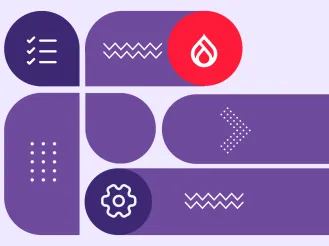Higher Education Digital Marketing: Strategy Framework for 2026
Planning your college or university's digital marketing for 2026? You're facing challenges that most industries never encounter: reaching two completely different audiences who both influence the same important decision, managing sales cycles that stretch across years, and competing not just locally but globally.
This isn't about quick conversions or impulse purchases. Prospective students research colleges for months, parents evaluate costs and outcomes methodically, and both groups expect seamless digital experiences that build trust over time.
This guide provides a strategic framework for thinking about higher education digital marketing. You'll learn how to approach the unique challenges of dual-audience marketing, build sustainable growth systems, and measure success in ways that matter to institutional decision-makers.
Why Higher Education Digital Marketing Is Different
Higher education digital marketing operates under constraints that most marketers never face. Understanding these differences shapes every strategic decision you make.
Two Different Audiences
You're marketing to teenagers who consume content constantly and parents who research major purchases methodically. Nearly three-quarters of teens visit YouTube every day, making video content essential for reaching students where they actually spend time. Meanwhile, 76% of U.S. adults make purchases using smartphones, meaning parents expect mobile-optimized experiences even when researching major decisions like college tuition.
This creates a fundamental tension: students want authentic content showing real campus life, while parents want detailed data about career outcomes, safety statistics, and return on investment. Your marketing needs to serve both audiences simultaneously without alienating either group.
Extended Decision Cycles
College selection takes months or years, not days or weeks. Students often start researching in sophomore year of high school and don't make final decisions until senior year. This extended timeline requires nurturing relationships rather than pushing for immediate conversions.
Your content strategy must support prospects through multiple phases: initial awareness, program evaluation, application consideration, and final enrollment decisions. Each phase requires different information and different communication approaches.
High-Stakes Decision Making
College represents one of the largest financial decisions families make, often involving tens of thousands of dollars and four years of a student's life. This high-stakes environment means prospects research exhaustively and expect detailed, accurate information.
Trust becomes more important than creativity. Prospects need confidence in your institution's ability to deliver promised outcomes. Your digital presence must demonstrate competence, stability, and genuine care for student success.
Global Competition Landscape
Your competition includes institutions across the country and around the world. More than 1.1 million international students study in the United States, while American students increasingly consider programs abroad.
Online learning has expanded competitive boundaries further, making digital marketing for college recruitment more complex than ever. Students can choose between local institutions, prestigious schools in other states, and innovative online programs worldwide. Your digital marketing must articulate why students should choose your institution among unlimited options.
Understanding Your Two Distinct Audiences
Effective digital marketing for universities requires a deep understanding of both students and parents. These groups research differently, prioritize different factors, and respond to different messaging approaches.
How Students Approach College Selection
Today's college-bound students are digital natives who expect immediate access to information and authentic interactions. Nearly half of teens say they're online almost constantly, using multiple platforms throughout their day.
Students discover colleges through social media, not traditional advertising. They follow campus accounts on Instagram, watch student-created content on TikTok, and research programs through YouTube videos. Authentic peer testimonials influence their decisions more than polished marketing materials.
42% of students begin their college search through search engines or school websites. They expect websites to load quickly, work perfectly on mobile devices, and provide clear pathways to the information they need.
Social media directly impacts their decision-making process. 55% of buyers make mobile purchases after seeing products on social media. For students, this translates to requesting information, scheduling campus visits, or submitting applications after discovering schools through social platforms.
How Parents Influence College Decisions
Parents focus on practical considerations: costs, career outcomes, campus safety, and long-term value. They research methodically, compare options, and often control final enrollment decisions through financial influence.
While parents research your institution they also check industry employment trends, alumni success rates, and comparative analysis with competing schools. They want transparent information about total costs, financial aid processes, and post-graduation support services.
Parents use different platforms than students. Facebook remains popular among parents for joining discussion groups and following institutional updates. LinkedIn appeals to career-focused parents researching professional program outcomes.
Search behavior differs significantly from students. Parents might use longer, more specific queries like "engineering programs with high job placement rates" or "colleges with strong mental health support services."
Creating Unified Messaging Strategies
The most effective approach addresses both audiences through carefully crafted content that serves dual purposes. "Career outcomes for marketing majors" interests students thinking about their futures and parents evaluating return on investment.
Content layering accommodates different research depths. High-level overviews satisfy casual browsers while detailed information supports thorough researchers. Some parents want comprehensive data they can save and analyze later, while students prefer quick videos they can watch between classes.
Platform selection becomes strategic rather than tactical. YouTube reaches both audiences but requires different content approaches. Campus life videos appeal to students, while parent information sessions serve family decision-makers.
Building Your Digital Foundation
A strong digital marketing strategy for higher education starts with foundational elements that support all other marketing activities. These foundations determine whether prospects can find you, engage with your content, and complete desired actions.
Search Engine Optimization Strategy
SEO matters more in higher education than most industries because college selection begins with search. Students and parents start their research by searching for programs, comparing schools, and investigating specific institutions.
Keyword strategy should align with different stages of the student journey. Early-stage searches include broad terms like "choosing a college major" or "best colleges in California." Later-stage searches become specific: "computer science program at State University" or "financial aid application deadline."
Local SEO helps regional institutions capture nearby prospects. Geographic keywords, location pages, and local business listings ensure you appear when students search for colleges in their area.
Technical performance directly impacts enrollment inquiries. 46% of users abandon sites that take more than 4 seconds to load on mobile. When students are comparing multiple institutions quickly, slow-loading pages eliminate your school from consideration.
Mobile devices generate 63% of web traffic, making mobile optimization essential rather than optional. Your application processes, program information, and campus resources must work flawlessly on smartphones.
AI and Generative Engine Optimization (GEO)
AI-powered search tools are changing how students find college information. ChatGPT, Google's AI Overviews, and other tools increasingly provide direct answers rather than lists of websites.
Content structure beats keyword density for AI optimization. FAQs, numbered lists, clear headings, and schema markup help AI systems understand and cite your content. Comprehensive coverage of topics increases the likelihood that AI tools will reference your institution when answering student questions.
Brand mentions across reputable sources signal authority to AI systems. When your institution appears in news articles, educational publications, and industry resources, AI tools view your school as a credible source worth citing.
Content Strategy Framework
Content marketing for colleges requires thinking in terms of student journey stages rather than individual pieces. Your content ecosystem should guide prospects from initial awareness through enrollment decisions.
Top-of-funnel content answers broad questions students ask when first considering college: choosing majors, understanding campus life, exploring career options. This content builds your institution's reputation as a helpful resource before students know specific schools they're considering.
Middle-of-funnel content helps students evaluate specific options through program comparisons, career outcome data, financial aid explanations, and detailed campus information. This content demonstrates your institution's strengths relative to competitors.
Bottom-of-funnel content removes final barriers to application. Application guides, deadline reminders, scholarship information, and student success stories help convert interested prospects into applicants.
Content should serve both audiences whenever possible. Student success stories appeal to prospects while demonstrating outcomes that matter to parents. Campus safety information addresses student life concerns and parent security worries.
Channel Strategy Across the Student Journey
Different marketing channels serve different purposes in the extended college selection process. Understanding which channels work best at each stage of the prospect’s journey can help you allocate resources effectively and create cohesive prospect experiences.
Awareness Stage Channel Strategy
Social media platforms drive initial awareness and brand building. YouTube works exceptionally well for higher education because it reaches both students and parents with different content types. Campus tours appeal to students, while parent information sessions serve family decision-makers.
TikTok reaches younger audiences through authentic, student-created content. Official institutional accounts perform best when they showcase real campus life rather than polished marketing messages. Partner with current students to create authentic content that resonates with prospects.
Instagram combines visual storytelling with community building. Campus photography, student spotlights, and behind-the-scenes content showcase your institution's personality and culture.
Content marketing builds authority and trust through helpful, educational material. Blog posts, downloadable guides, and resource pages establish your institution as a valuable information source before prospects are ready to apply.
Consideration Stage Channel Strategy
Email marketing nurtures relationships during the extended research process. Prospects who express initial interest need ongoing communication that provides value while keeping your institution top-of-mind.
Email sequences should align with natural decision timelines. High school juniors need different information than seniors. Transfer students have different concerns than first-time college students. Segment your communications based on prospect characteristics and interests.
Retargeting campaigns re-engage website visitors who didn't complete desired actions during their first visit. Display ads showcasing specific programs, campus highlights, or student testimonials can bring prospects back for deeper engagement.
Social media advertising extends your organic reach to specific audience segments. Facebook and Instagram ads reach parents effectively, while TikTok and Snapchat appeal to younger prospects.
Decision Stage Channel Strategy
Conversion optimization removes barriers to application completion. Your application process, campus visit scheduling, and information request forms must work flawlessly across all devices.
Live chat and phone support address last-minute questions that prevent applications. Many prospects have specific concerns about admissions requirements, financial aid, or program details that require personal assistance.
Email automation supports prospects through application processes with deadline reminders, required document checklists, and encouragement messages that reduce abandonment rates.
Retention and Re-engagement Opportunities
Re-enrollment campaigns target former students with updated program options, flexible scheduling, and support services that address common barriers to completion. These campaigns often generate higher ROI than new student acquisition because former students already understand your institution's value.
Alumni engagement supports long-term institutional reputation and can generate referrals from successful graduates who recommend your programs to friends, family, and colleagues.
Measuring What Matters in Higher Ed Marketing
Higher education marketing measurement requires different approaches than most industries because success happens over months or years rather than days or weeks. Traditional conversion metrics miss the complexity of institutional decision-making and long-term student outcomes.
Beyond Vanity Metrics
Lead quantity matters less than lead quality in higher education. A smaller number of qualified prospects who actually enroll generates better ROI than large numbers of unqualified inquiries that never convert.
Cost per inquiry provides baseline efficiency measurement, but cost per enrollment reveals true marketing effectiveness. Track both metrics to understand funnel performance and identify optimization opportunities.
Engagement depth indicates prospect seriousness better than simple traffic metrics. Time spent on program pages, multiple campus visit requests, and email engagement patterns help identify prospects most likely to apply and enroll.
Attribution Challenges and Solutions
Students typically interact with multiple marketing touchpoints before applying. They might discover your school through social media, research programs on your website, attend virtual information sessions, and receive email nurture sequences before submitting applications.
Multi-touch attribution provides more accurate pictures of marketing effectiveness than last-click attribution. Understanding which combinations of touchpoints drive enrollment helps optimize marketing mix and budget allocation.
Offline interactions complicate digital attribution. Campus visits, phone calls, and information sessions influenced by digital marketing require manual tracking to connect offline conversions to digital campaigns.
Long-term Value Measurement
Lifetime value calculations should include a full student lifecycle: tuition payments, fee revenue, alumni engagement, and referral generation. Students who complete programs successfully become long-term institutional assets.
Student success metrics reflect marketing effectiveness over time. High-quality marketing that attracts well-matched students should correlate with better retention rates, higher graduation rates, and stronger career outcomes.
Ready to Transform Your Institution's Digital Marketing?
Higher education digital marketing success requires understanding the unique challenges facing educational institutions while executing proven digital marketing fundamentals. The framework outlined in this guide provides strategic direction, but implementation determines results.
Developing a comprehensive digital marketing strategy for higher education requires expertise in both technical execution and the specific needs of higher education institutions. The most successful colleges and universities work with partners who understand dual-audience marketing complexities and the importance of measurable enrollment outcomes.
ImageX has helped colleges and universities across North America create digital experiences that attract, engage, and convert both students and parents. Our team understands the strategic challenges of higher education marketing and delivers solutions that drive sustainable enrollment growth.
Your prospective students are researching their futures right now. Make sure your institution provides the digital experiences that earn their consideration and trust.








